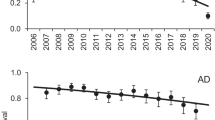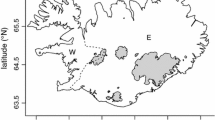Abstract
The age-sex composition of a chacma baboon (Papio ursinus)population changed following a 5-month interval of extreme food and water shortages. Mortality was significantly greater among adult females, juveniles, and infants than among adult males. The probable basis of 19 of 22 deaths during the interval of food and water shortage was starvation caused by drought conditions which localized water sources, reducing access to food resources. This resulted in a long-term (> 6-year) shift in adult sex ratios within this three-troop population, from 1.04 to 1.42-1.58 adult and subadult males per adult female. Patterns of intertroop interaction were also influenced by food scarcity, which determined which troop was most seriously affected.
Similar content being viewed by others

References
Alexander, R. F. (1974). The evolution of social behavior.A Rev. Ecol. Syst. 5: 325–384.
Altmann, S. A., and Altmann, J. (1970).Baboon Ecology. African Field Research, University of Chicago Press, Chicago.
Altmann, S. A., and Altmann, J.0 (1979). Demographic constraints on behavior and social organisation. In Bernstein, I. R., and Smith, E. O. (eds.),Primate Ecology and Human Evolution, Garland STMP, New York, pp. 47–63.
Busse, C. D. (1980). Leopard and lion predation upon chacma baboons living in the Moremi Wildlife Reserve.Botswana Notes Rec. 12: 15–21.
Busse, C. D., and Hamilton, W. J., III (1981). Infant carrying by male chacma baboons.Science 212: 1281–1283.
Cheney, D. L., and Seyfarth, R. M. (1977). Behaviour of adult and immature male baboons during inter-group encounters.Nature (Lond.) 269: 404–406.
Crook, J. H., and Aldrich-Blake, P. (1968). Ecological and behavioural contrasts between sympatric ground dwelling primates in Ethiopia.Folia primatol. 8: 192–227.
Dittus, W. P. J. (1980). The social regulation of primate populations: A synthesis. In Lindburg, D. G. (ed.),The Macaques. Studies in Ecology, Behavior and Evolution, Van Nostrand Reinhold, New York, pp. 263–286.
Dunbar, R.I.M. (1979). Population demography, social organisation and mating strategies. In Bernstein, I. R., and Smith, E. O. (eds.),Primate Ecology and Human Evolution, Garland STPM, New York, pp. 254–275.
Dunbar, R. I. M., and Dunbar, P. (1975).Social Dynamics of Gelada Baboons. Contributions to Primatology, Vol. 6, Karger, Basel.
Hamilton, W. J., II (1982). Baboon sleeping site preferences and relationships to primate grouping patterns.Am. J. Primalol. 3: 31–53.
Hamilton, W. J., III (1985). Namib Desert chacma baboon (Papio ursinus) use of food and water during a food shortage.Madoqua (in press).
Hamilton, W. J., III, and Tilson, R. L. (1982). Solitary male chacma baboons in a desert canyon.Am. J. Primalol. 3: 41–53.
Hamilton, W. J., III, Buskirk, R. E., and Buskirk, W. H. (1974). Troop-mobilizing behavior of adult male chacma baboons.Folia primatol. 22: 9–18.
Hamilton, W. J., III, Buskirk, R. E., and Buskirk, W. H. (1975). Chacma baboon tactics during intertroop encounters.J. Mammal. 56: 857–870.
Hamilton, W. J., III, Buskirk, R. E.,and Buskirk, W. H. (1976). Defense of space and resources by chacma (Papio ursinus) baboon troops in an Africa desert and swamp.Ecology 57: 1264–1272.
Hamilton, W. J., III, Buskirk, R. E., and Buskirk, W. H. (1977). Intersexual dominance and differential mortality of gemsbokOryx gazella at Namib Desert waterholes.Madoqua 10: 5–19.
Hamilton, W. J., III, Buskirk, R. E., and Buskirk, W. H. (1978). Omnivory and utilization of food resources by chacma baboons,Papio ursinus. Am. Nat. 112: 911–924.
Marais, E. (1969).The Soul of the Ape, Atheneum, New York.
Ohsawa, H., and Dunbar, R. I. M. (1984). Variations in the demographic structure and dynamics of gelada baboon populations.Behav. Ecol. Sociobiol. 15: 231–240.
Rasmussen, D. R. (1979). Correlates of patterns of range use of a troop of yellow baboons (Papio cynocephalus). 1. Sleeping sites, impregnable females, births and male emigrations and immigrations.Anim. Behav. 27: 1098–1112.
Seely, M. K., Buskirk, W. H., Hamilton, W. J., III, and Dixon, J. E. W. (1980). Lower Kuiseb River perennial vegetation survey.SWA Wissenschaft. Gesell. J. 34/35: 57–86.
Sigg, H. (1980). Differentiation of female positions in hamadryas one-male-units. Z.Tierpsychol. 53: 265–303.
Stoltz, L. P., and Saayman, G. A. (1970). Ecology and behavior of baboons in the Northern Transvaal.Ann. Transvaal Mus. 26: 99–143.
van Schaik, C.P. (1983). Why are diurnal primates living in groups?Behaviour 87(1-2): 120–144.
van Schaik, C.P., and van Hooff, J.A. R. A. M. (1983). On the ultimate causes of primate social systems.Behaviour 85: 91–117.
Wrangham, R. W. (1980). An ecological model of female-bonded primate groups.Behaviour 75: 262–298.
Author information
Authors and Affiliations
Rights and permissions
About this article
Cite this article
Hamilton, W.J. Demographic consequences of a food and water shortage to desert Chacma Baboons,Papio ursinus . Int J Primatol 6, 451–462 (1985). https://doi.org/10.1007/BF02735570
Received:
Revised:
Issue Date:
DOI: https://doi.org/10.1007/BF02735570



